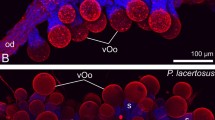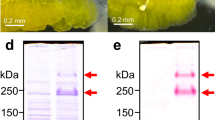Abstract
THE uterine or milk glands in tsetse flies (Glossina spp.) are modified female accessory reproductive glands which elaborate and release a nutritive liquid of proteinaceous and lipoid nature for the maturing intrauterine larva1–3. The multi-branched tubules of the gland converge into a pair of efferent ducts which fuse inside the oviductal shelf and open into the lumen of the uterus just posterior to the opening of the oviduct4,5. Cytological details of the milk gland and their modulations in relation to the state of pregnancy of the female have been described6 (W-C. M., D. L. D., D. S. Smith and U. Jarlfors, in preparation). Earlier work has suggested that milk is released directly into the lumen of the gland by apocrine secretion4. Our observations on the structure of the milk gland do not support such a mechanism, but rather, a novel type of exocrine discharge in which secretion is stored in an extracellular reservoir and released into the lumen through a dense cuticular network. At the points of milk release the lumen is frequently inhabited by bacteria which have not previously been described in milk glands. Our examination is based on milk glands from G. morsitans morsitans West-wood, but a comparative study using G. austeni Newstead and G. longipalpis pallidipes Austen has shown no essential differences among the three species.
This is a preview of subscription content, access via your institution
Access options
Subscribe to this journal
Receive 51 print issues and online access
$199.00 per year
only $3.90 per issue
Buy this article
- Purchase on Springer Link
- Instant access to full article PDF
Prices may be subject to local taxes which are calculated during checkout
Similar content being viewed by others
References
Minchin, E. A., Proc. R. Soc., B. 76, 531–547 (1905).
Stuhlmann, F., Arb. K. Gesundhamt., 26, 301–383 (1907).
Roubaud, E., Thesis, Paris University (1909).
Hoffmann, R., Acta trop., 11, 1–57 (1954).
Roberts, M. J., Parasitology, 64, 23–36 (1972).
Denlinger, D. L., and Ma, W-C., J. Insect Physiol., (in the press).
Tobe, S. S., Davey, K. G., and Huebner, E., Tissue and Cell (in the press).
Glauert, A. M., and Thornley, M. J., A. Rev. Microbiol. 23, 159–199 (1969).
Bisset, K. A., 6th Symp. Soc. Gen. Microbiol., (Cambridge, University Press, London, 1956).
Roubaud, E., Ann. Inst. Pasteur, 33, 489–537 (1919).
Wigglesworth, V. B., Parasitology, 21, 288–321 (1929).
Reinhardt, C., Steiger, R., and Hecker, H., Acta trop., 29, 280–288 (1972).
Duguid, J. P., and Gillies, R. R., J. Path. Bact., 74, 397 (1957).
Author information
Authors and Affiliations
Rights and permissions
About this article
Cite this article
MA, WC., DENLINGER, D. Secretory discharge and microflora of milk gland in tsetse flies. Nature 247, 301–303 (1974). https://doi.org/10.1038/247301a0
Received:
Revised:
Issue Date:
DOI: https://doi.org/10.1038/247301a0
This article is cited by
-
The holobiont transcriptome of teneral tsetse fly species of varying vector competence
BMC Genomics (2021)
-
Genome sequence of the endocellular obligate symbiont of tsetse flies, Wigglesworthia glossinidia
Nature Genetics (2002)
-
Cyclic AMP is a likely mediator of ovulation in the tsetse fly
Experientia (1978)
-
Symbionts in the female tsetse flyGlossina morsitans morsitans
Experientia (1975)
-
Bacteroids in the ovaries of a tsetse fly
Nature (1974)
Comments
By submitting a comment you agree to abide by our Terms and Community Guidelines. If you find something abusive or that does not comply with our terms or guidelines please flag it as inappropriate.



